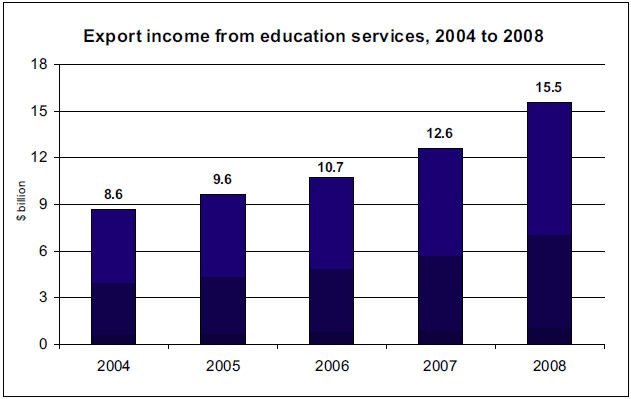
The Detrimental Increasing Dependence of Our Universities on International Students' Fees

|
Editorial
- 31 August 2009 |
|
|
|
Note Correction Regarding Figures for Monash University at the end of this editorial.
|
|
The Detrimental Increasing Dependence of Our Universities on International Students' Fees |
|
In 1988 Maxine Singer was invited to become president of Carnegie Institution of Washington, a position she held until her retirement in 2002. In a recent editorial in the journal Science Dr Singer opined that many countries are striving to develop the human resources required to advance science and technology and that the quality of teaching in the sciences, technology, engineering and mathematics (STEM) is of singular importance to the nation, to the success of students, and requires "great teachers, who know the content. She then cautioned her readers: Herein lies a major challenge: How to develop and cultivate great STEM teachers?
In July 2006 the
then Minister for Education, Science and Training, Julie Bishop, released
the official
audit of Australia's scientific, engineering and technology skills![]() .
During its tenure in office the Coalition Government under the Prime
Ministership of John Howard had under-resourced the maintenance and
development of "Science, Engineering and Technology Skills" to the point
that the "audit" warned in its final report that Australia is likely to
suffer a short-fall of as much as 35% in its estimated requirement of 55,000
additional scientific professionals, i.e. just over 19,000
individuals less than required.
.
During its tenure in office the Coalition Government under the Prime
Ministership of John Howard had under-resourced the maintenance and
development of "Science, Engineering and Technology Skills" to the point
that the "audit" warned in its final report that Australia is likely to
suffer a short-fall of as much as 35% in its estimated requirement of 55,000
additional scientific professionals, i.e. just over 19,000
individuals less than required.
In the intervening three years the governing Coalition has been replaced by a Labor government which had promised an education revolution but which has also had to cope with the "global economic crisis".
A more insidious problem is indicated by the chart provided in the Lowy Institute's policy brief, Australia’s Poisoned Alumni: International Education and the Costs to Australia. It demonstrates there has been an increasing dependency on "export" income from educational services amounting to 45% from 2006 to 2008.

But concurrently there has been no increase in the staffing of university positions in mathematics and the sciences; in fact staff have diminished.
Leaving aside the problems being caused by shonky vocational providers and inappropriate migration policies alluded to recently by RMIT's vice-chancellor, Margaret Gardner, our major universities, those which would be expected to supply the majority of the most qualified scientific professionals to Australia, have shown an alarming dependency on international students registrations.
For example:
Sydney University's international students constitute 22% of the student body.
Melbourne University -- 28% are international students.
Adelaide University -- 24% are international students.
University of Western Australia -- 20% are international students.
Monash University -- 24% are international students within Australia.*
Michael Wesley, author of the Lowy Institute's policy brief suggests: "Public funding for tertiary education should be reviewed to remove the incentive for institutions to maximise earnings from international education."
While a number of European nations charge international students minimal fees, such an approach would be difficult to institute in Australia. However, the possibility of fees being paid into a separately administered pool should be explored. It would be used to bolster the revenues of institutions shown to be furthering the nation's commonweal rather than pandering to the immediate desire to expand facilities for popular courses to the detriment of the nation. The total number of international students might drop, but the prospective improvement of the nation's universities with respect to providing learning and research would have significant prospects of improving.
Of course it would also help if the nation's parliamentarians would look upon adequate support for the universities as being an investment rather than an expense.
To date no programs have been put into place to remedy the shortage of well qualified science and mathematics teachers in Australia's public secondary schools. Unless and until a long-term, bipartisan initiative is undertaken, the deficiency will remain as nothing other than a talking point.
Dr Singer suggests in her Science editorial: "Excellent undergraduate students who are not dedicated to research should be encouraged by their science faculty to become STEM teachers [and] those who pursue advanced degrees and certification for STEM teaching should be offered fellowships;" while Peter Hall in 2007 as President of the Australian Mathematical Society asked the rhetorical question:
How can we preserve diversity in scientific research, and at the same time enhance our strengths, in an environment where research funding is at best static? Perhaps the only feasible approach is to have periodic reviews of research in Australian universities, not just in the mathematical sciences but also in other fields, conducted largely by scientists and scholars based abroad. Those reviews should identify gaps in our capability that need to be filled, as well as areas where we are excellent. They should be authoritative, and have teeth; that is, our research funders and research managers must heed the reviewers’ advice.
Above all, what should be seen as a serious and immediate danger is a policy that can by legitimately described as governmental pursuit of a Gresham's Law of university funding.
_____________________________________________
*Correction:
The figure originally given in the editorial for the percentage of Monash University's international students was 32% which included those students at Monash's South African and Sunway campuses (http://www.monash.edu.au/about/stats.html). Monash's DVC International has provided the following figures.
Year 2008
International on-shore students: 23.9%
Total students at all Australian campuses: 49,269
Total on-shore international students: 11,798
Total international students (including South Africa, Sunway and
off-shore partners): 33.7%
Total students at Monash: 56,573
Total international students at Monash: 19,079
Alex Reisner
The Funneled Web